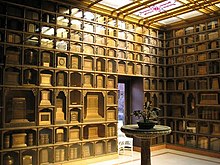Chapel of the Chimes (Oakland, California)
 From Wikipedia - Reading time: 5 min
From Wikipedia - Reading time: 5 min


| Designations | |
|---|---|
| Designated | 1999 |
| Reference no. | 129 |
Chapel of the Chimes was founded as California Electric Crematory in 1909 as a crematory and columbarium at 4499 Piedmont Avenue, at the entrance of Mountain View Cemetery in Oakland, California. The present building dates largely from a 1928 redevelopment based on the designs of the architect Julia Morgan.[1] The Spanish Gothic architecture features Moorish motifs and the interior is a maze of small rooms featuring ornate stonework, statues, gardens, fountains, and mosaics.
History
[edit]
The chapel originates with a crematory built in 1909 by the California Crematorium Association on the site of a trolley car station; the old structure still has train schedules on the wall. Architect Julia Morgan was hired to expand the facility; the new crematory and columbarium were dedicated on Memorial Day 1928, named Chapel of the Chimes for the chimes in the tower. Architect Aaron Green, a protégé of Frank Lloyd Wright, subsequently contributed six additions over 24 years, including mausoleums.[2]
The building maintains its original functions and also serves as the venue for annual music festivals on the winter and summer solstices.[3]
The chapel's owners operate funeral homes and cemeteries, not designed by Morgan, in Hayward, also under the name Chapel of the Chimes, as well as Sunset Lawn Chapel of the Chimes in Sacramento.[4]
Chapel of the Chimes holds the records of the Chapel of Memories on Pleasant Valley Avenue.
Garden of Memory
[edit]| Garden of Memory | |
|---|---|
 | |
| Genre | Electronic music, experimental music |
| Dates | Evening of the summer solstice |
| Location(s) | Chapel of the Chimes (Oakland, California) |
| Years active | 1996–present |
| Website | Garden of Memory |
Garden of Memory has been held 1996–present; this is a columbarium walk-through event held every year on the evening of the summer solstice.[5] It features over 40 musicians performing on unique instruments, or compositions designed for the event. The sound is often electronic or electro-acoustic in source and then electronically processed.[6]
Notable interments
[edit]Notable burials include the following:
- Harriet Chalmers Adams (1875–1937), explorer
- Malcolm Playfair Anderson (1879–1919), explorer and zoologist
- Dick Bartell (1907–1995), baseball player
- Russ Christopher (1917–1954), baseball player
- Frederick George Coppins (1889–1963), Canadian recipient of the Victoria Cross in World War I
- Al Davis (1929–2011), National Football League executive and Oakland Raiders owner
- John A. Elston (1874–1921), US Congressman
- Wesley Englehorn (1890–1993), college football player and coach
- William Frederick "Bones" Ely (1863–1952), baseball player
- John Lee Hooker (1917–2001), musician
- Charles Goodall Lee (1881–1973), first Chinese American dentist
- Stephen Stucker (1947–1986), actor, comedian
- Friend Richardson (1865–1943), California governor
- Henry Vollmer (1867–1930), mayor of Davenport, Iowa, US Congressman
- Herbert Archer (H.A.) Richardson, timber and shipping magnate
- Grace Richardson Butterfield, California State Parks Board, Grand Matron of the Eastern Star
See also
[edit]References
[edit]- ^ Chapel of the Chimes Oakland. "Chapel of the Chimes Oakland – Oakland, CA". Oakland.chapelofthechimes.com. Retrieved August 25, 2014.
- ^ "A Piece of History: Chapel of the Chimes Oakland". Chapel of the Chimes Oakland. June 29, 2012. Retrieved April 25, 2022.
- ^ "a columbarium walk-through event at the Chapel of the Chimes". Garden of Memory. Retrieved August 25, 2014.
- ^ [1] Archived December 3, 2010, at the Wayback Machine
- ^ Jason Victor Serinus. "A mystical, musical garden of memory". San Francisco Examiner. Archived from the original on August 5, 2012. Retrieved September 20, 2011.
- ^ "Garden of Memory – a columbarium walk-through event at the Chapel of the Chimes".
External links
[edit]- Garden of Memory
- Chapel of the Chimes (Oakland, California)
- U.S. Geological Survey Geographic Names Information System: Chapel of the Chimes Cemetery
- U.S. Geological Survey Geographic Names Information System: Chapel of the Chimes Memorial Park
- Chapel of the Chimes Columbarium and Mausoleum at Find a Grave
 KSF
KSF